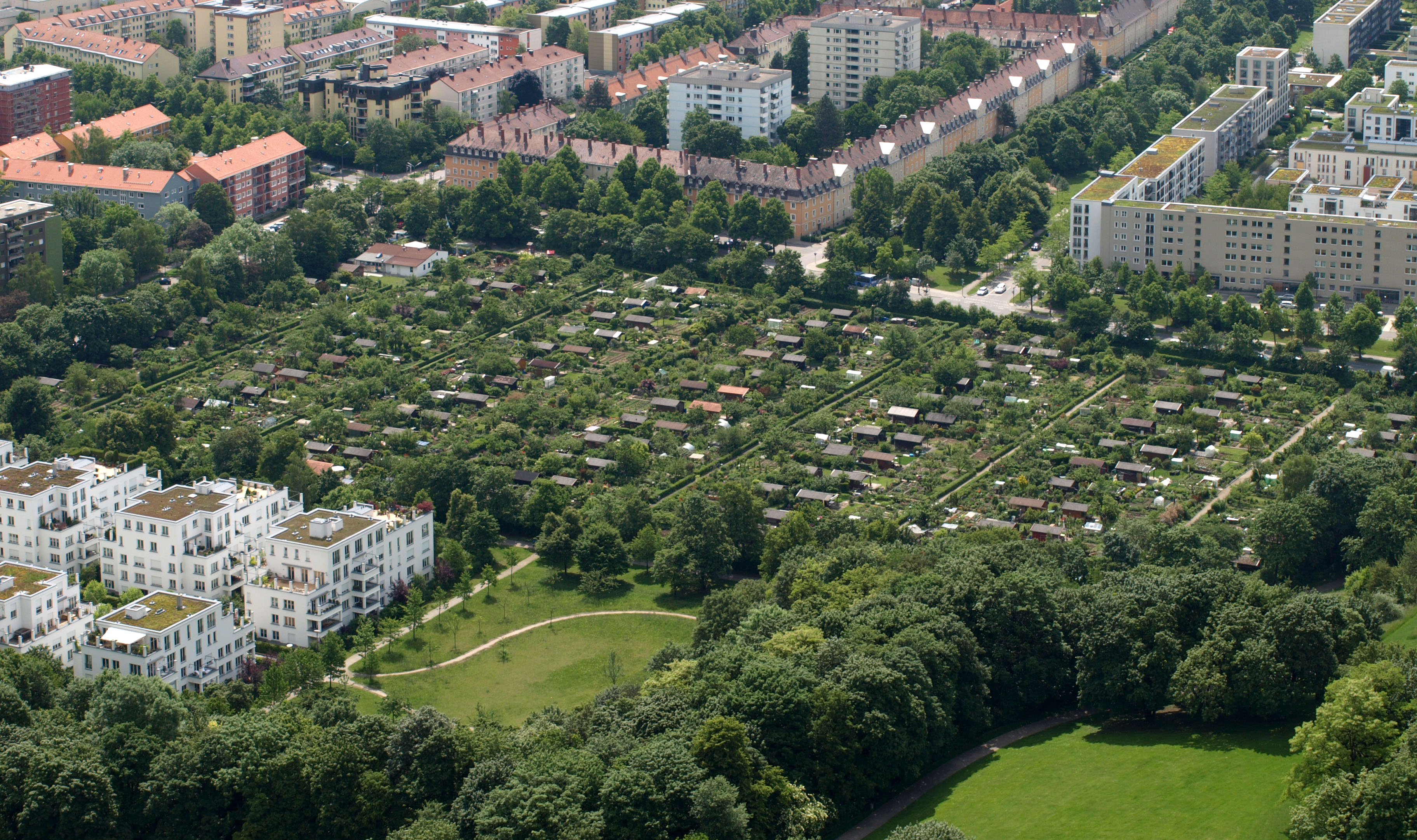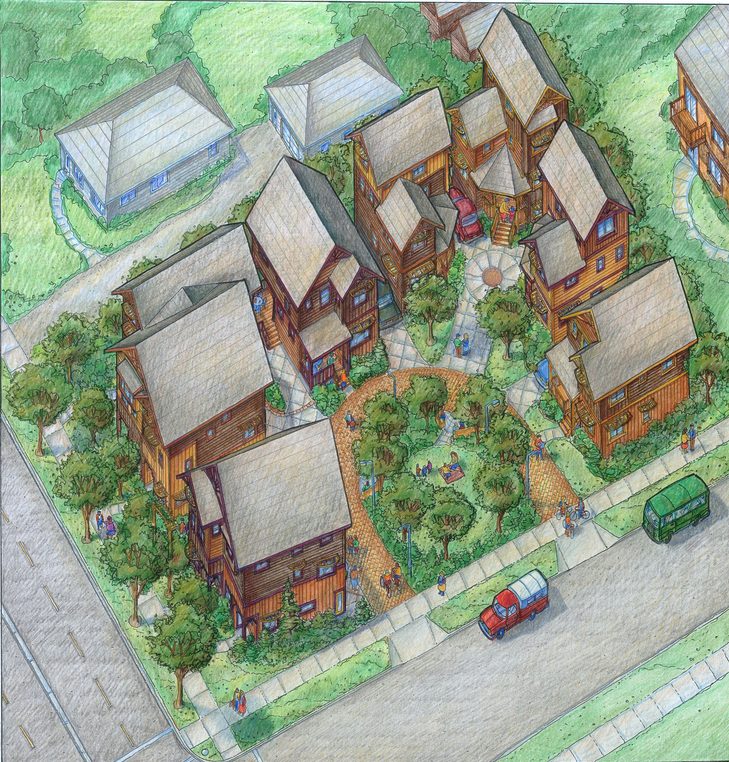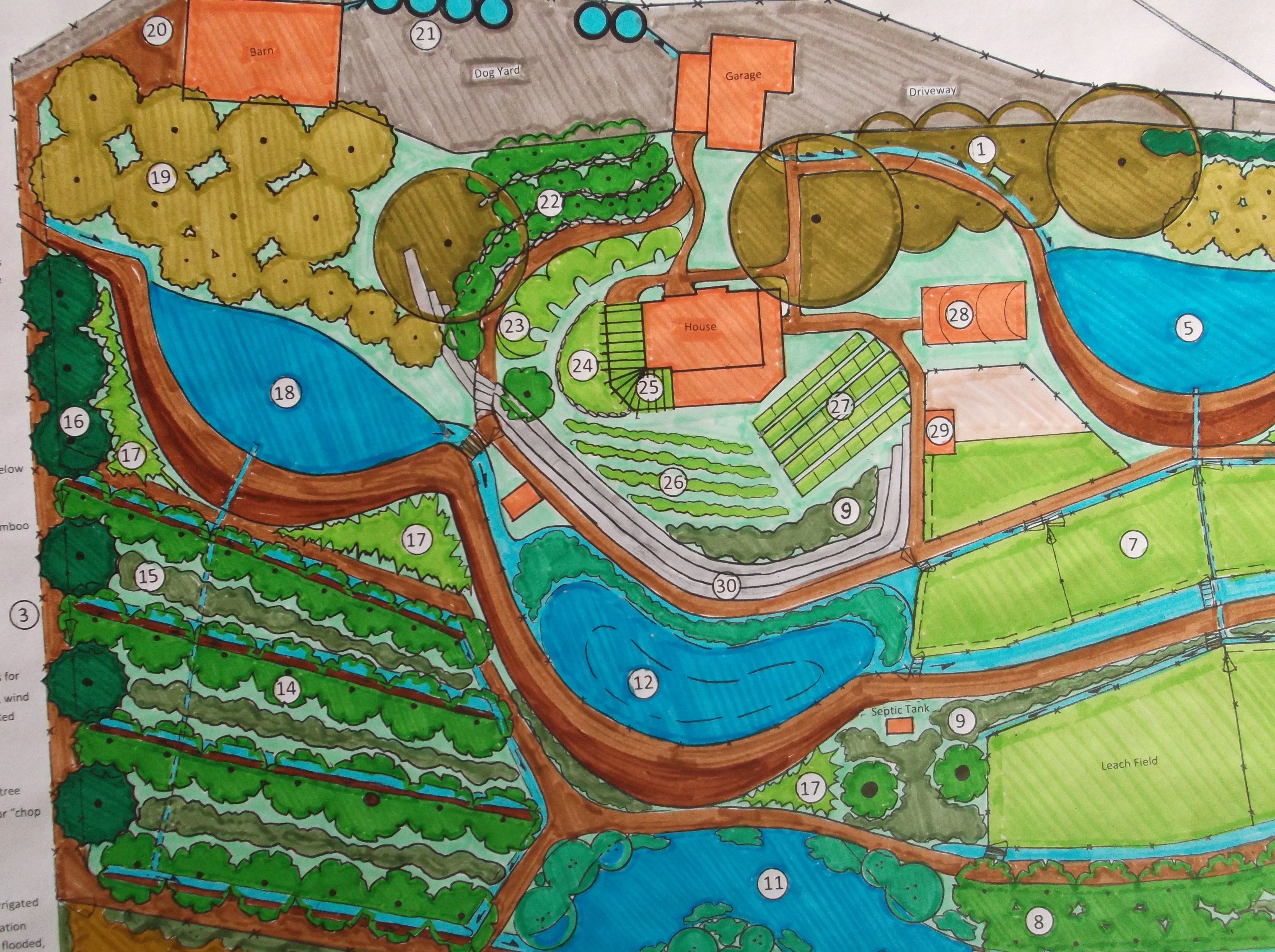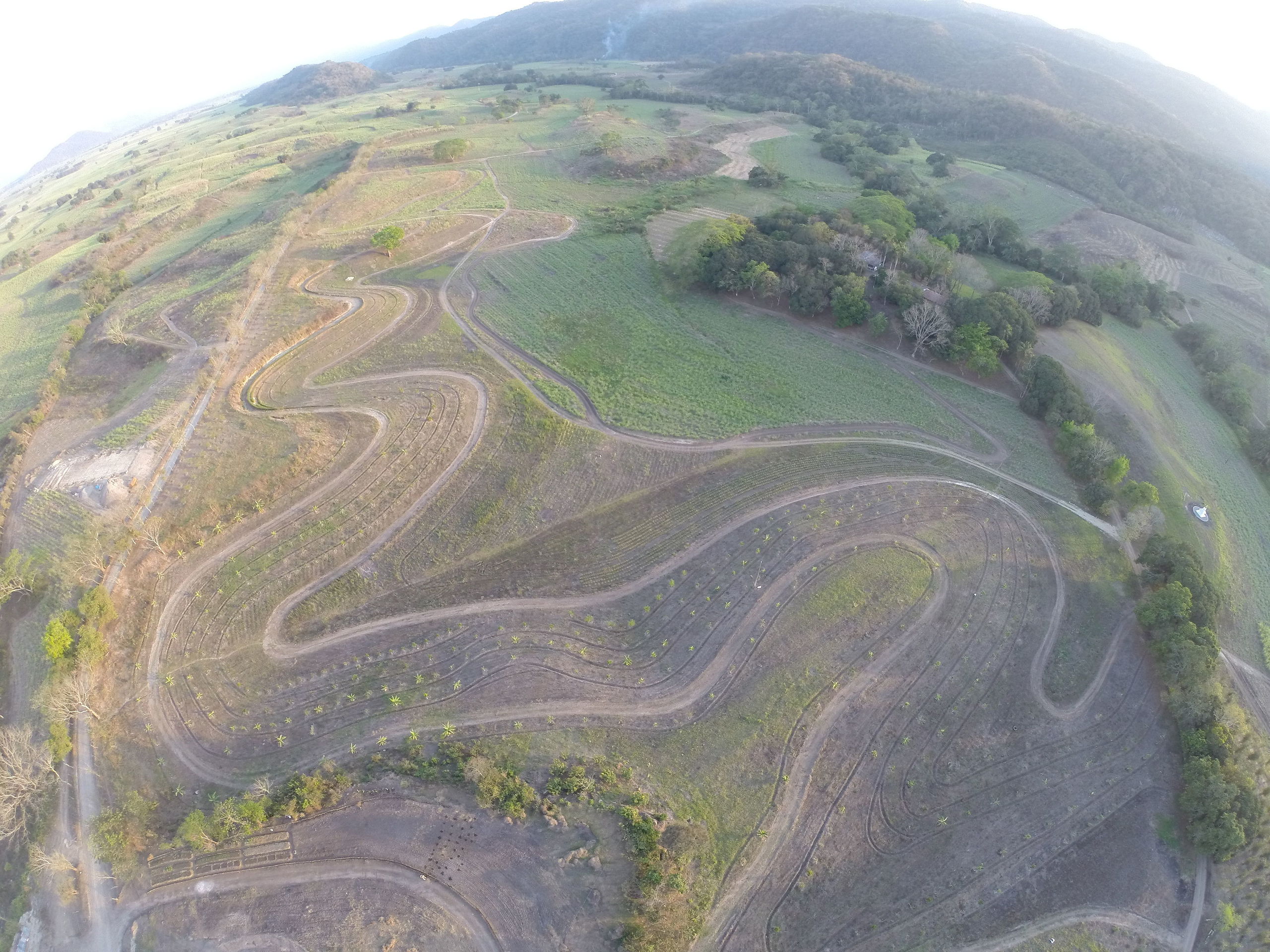6 Scales of System
1. Urban Permaculture
There are widespread examples of Permaculture systems at the urban scale throughout the world. On balconies, rooftops, small yards and empty lots, we find intensively cultivated and highly productive systems. Permaculture designs in urban areas are packed tightly, making the most use of limited space through complex relationships between rainwater and wastewater flow, food production, composting, sunlight, pollinator habitat, social areas, and the urban waste stream which can provide free and inexpensive materials for building structures and soil. Below are links to urban Permaculture projects and resources:
- Seattle Homestead
- The Institute of Urban Homesteading Oakland, CA
- Urban Permaculture Guild, Berkeley, CA
- Planet Repair Institute, Portland, OR
- Deep Green Permaculture, Melbourne, Australia
- Article: How the Reading International Solidarity Centre built an urban permaculture garden, UK
- Milkwood Blog Funky Urban Permaculture Designs, Melbourne Australia
- The Permaculture Podcast with Scott Mann
- Top Leaf Farms specializing in rooftop farms
- Permaculture Association’s resource guide to Sustainable Urban Drainage
- Little Farm L.A.
2. Suburban Permaculture
Suburban-scaled Permaculture systems are rich with possibilities . As co-founder David Holmgren said: “Suburban sprawl in fact gives us an advantage. Detached houses are easy to retrofit, and the space around them allows for solar access and space for food production. A water supply is already in place, our pampered, unproductive ornamental gardens have fertile soils and ready access to nutrients..”. When we look throughout the world, we find abundant examples of suburbs that have filled in with productive Permaculture systems. The lower density of suburbs means that there is a lot of space for more expansive gardens, animals, tree crops, and land-based livelihoods. Below are links to suburban Permaculture projects and resources:
- Adaptation of David Holmgren’s lecture on Retrofitting the Suburbs for Sustainability
- Suburban Permaculture, information and resources to transform the suburban environment
- Growing Futures Kenya, Suburban Permaculture Development (inactive link as of 05/17/2021)
- Midwest Permaculture, 18 part Intro to Permaculture video series
- Erik Ohlsen’s Suburban Permaculture Garden Tour Video
3. Permaculture in Public Space

Especially in urban areas, we find very rich examples of Permaculture systems which take advantage of the diversity of the ‘human ecosystem’ found there. Gathering places, public parks, and community food forests all contribute to the sustainability and resilience of a community. It’s not just food, water and habitat that can make a place resilient; it’s the social connections between people that make a strong and secure community where people know each other and help each other out. Permaculture in public spaces is often centered around places where people can gather and meet each other, so they have more of an opportunity to make those connections. Below are links to public Permaculture projects and resources:
- The City Repair Project, Portland OR
- Keepers of the Waters, artistic, community centered remediation of living water systems (inactive link as of 05/17/2021)
- Beacon Food Forest, Seattle, WA
- Permaculture Park, Ithaca, NY
4. Multi-unit Urban Development

As Permaculture design has spread into more conventional fields, developers, architects, planners and landscape architects have utilized it to design multi-unit housing projects. Permaculture is about applying different patterns to the layout of a housing subdivision, with attention to solar access, energy systems, water flow, pathways, and a productive landscape for people and wildlife. Development projects at this scale are already investing in buildings, utilities, drainage, and road infrastructure, so often it’s just the matter of having proper positioning, orientation and interconnection between these elements that creates the ‘mainframe’ for a more regenerative settlement. Below are links to multi-unit Permaculture projects and resources:
- Village Homes, Davis CA
- Milagro CoHousing, Tucson AZ
- Columbia Eco Village, Portland, OR
- Permaculture Design International, project in Eastern Oregon
5. Ecovillage

The loose term for a Permaculture-based village or community is ‘ecovillage’, which is short for ecological village. There are many inspiring examples all over the world of how Permaculture design is applied to create intentional communities, as well as transforming existing villages in traditional cultures and contemporary settlements. Ecovillage design is a very rich field, where the elements of food, water, energy, materials, ecology, housing, and forestry are woven in with community political structures, economics, urban planning, and all the challenges and opportunities of sharing resources. Below are links to ecovillage Permaculture projects and resources:
- Auroville, India
- The Chikukwa Project, Zimbabwe (inactive link as of 05/17/2021)
- Crystal Waters, Australia
- Tamera, Portugal
- Permaculture Association, Housing Resources
6. Retreat and Healing Centers

Many people have utilized Permaculture design when creating healing or retreat centers. It’s been used both for retreat centers that are built from the ground up in colonized areas, as well as indigenous people practicing traditional medicine in their native lands. The fact that two of Permaculture’s ethics are care of Earth and care of people means that the design system is very conducive to the healing environment of hot springs, yoga centers, ashrams, retreat centers, alternative medical facilities, indigenous medicine centers, and eco-resorts. In these environments, the natural patterns of Permaculture can bring a heightened aesthetic that is functional and productive. Below are links to retreat and healing center Permaculture projects and resources:
- Eco-Friendly Africa Travel
- Living Art Farm, South Africa
- Chakra Alegria de Amor Rainforest Healing Center, Peru (inactive link as of 05/17/2021)
- Paititi Institute, Peru
- Chaikuni Institute, Peru
- Heartwood Institute, Garberville, CA
7. Homestead

For this list, the homestead scale refers to a rural property that is bigger than a suburban lot but smaller than a working farm. This means that the area under management is between 1 and 5 acres or .5-2 hectares. A homestead will not usually rely solely on the fruits of their land for income and sustenance, but is big enough to have more diverse and extensive production systems. This is a very popular scale for Permaculture projects throughout the world, and offers the potential for significant animal rotation, growing large trees, ponds with more substantial water collection, multiple larger structures, and profitable cottage industry with multiple residents. There are some really beautiful Permaculture homesteads out there! Below are links to some projects and resources:
8. Farms

Permaculture farms are diverse agricultural systems that are designed with a range of different enterprises that work together to make profitable businesses and healthy landscapes. The layout of a Permaculture farm is influenced by the shape of the land, to maximize production and minimize effort while building soil, benefiting the water cycle, and providing long-term resilience and abundance to the farmers. Permaculture farms look different than conventional farms because they work with natural patterns and integrate animals, crops, trees, water storage, renewable energy, and people in a harmonious and productive way. Below are links to Permaculture farm projects and resources:
- Taranaki Farm, Australia
- Forest Agriculture Enterprises, Viola, WI
- Seven Seeds Farm, Williams, OR
- Bullocks Permaculture Homestead, Orcas Island, WA
- Ridgedale Permaculture, Sweden
- Rancho San Ricardo, Mexico (pictures above)
9. Educational Centers
There are many overlaps on these scales of systems, especially for educational centers, because many are also farms, homesteads, suburban lots, urban lots, or retreat centers. Permaculture demonstration sites with a focus on bringing people into touch with the systems, learn, and be inspired is a category of Permaculture sites that we find. Demonstration sites are often some of the most rich and diverse ones because they are designed for interaction and education of the public. Many sites offer full Permaculture Design Courses (PDC), which we encourage you to take if you want to get deeper into this inspiring field. Below are links to Permaculture educational centers:
- Quail Springs Permaculture, California
- Fambidzanai Permaculture Center, Zimbabwe
- Zaytuna Farm, Australia
- Maya Mountain Research Farm, Belize
- Aprovecho, Cottage Grove, OR
10. Broad Scale Agroforestry
It is not just homesteads and farms that have taken up Permaculture. Some large commercial and industrial-scale producers have seen the value of Permaculture systems and investing in large scale projects that are benefitting whole regional economies, ecology, hydrology, and food security. There are corporations who have invested in these projects, like M&M Mars Inc. in Vietnam. There are also projects that are not under the name “Permaculture”, and are called agroforestry, yet share many of the same design principles, strategies and techniques. This is a growing area where there is the potential for industries to apply Permaculture design to existing supply chains, which turns consumer dollars into agents of land regeneration, like Lush Cosmetics is doing (link below). Below are links to broad scale Permaculture and agroforestry projects and resources:
- Ghana Permaculture Institute
- Lush Cosmetics, UK
- Sadhana Forest, Haiti
- Cacao Agroforestry in Vietnam (inactive link as of 05/17/2021)
11. International development

International development is another field ripe for the application of Permaculture design. There are already many channels where money, experts and other resources are working to assist in the economic development of other countries, and Permaculture has it’s own initiatives to make international development sustainable and regenerative for economies, ecosystems, and societies. Many non-profit organizations already employ Permaculturalists to conduct trainings and development projects in many countries. Below are links to Permaculture international development projects and resources:
- Permaculture Research Institute, Resiliency in International Development
- Permaculture Research Institute, Integrating Permaculture & International Development
- Quail Springs Permaculture, PDC for International Development (inactive link as of 05/17/2021)
- Accounting For International Development, Permaculture Institute of El Salvador
12. Disaster Relief and International Aid

There are many instances where teams of Permaculture “first responders” have arrived in areas after a major natural or human-made disasters. Often times this is with the support of a non-governmental organization. Permaculture is very suited to organizing safe and ecological survival systems in refugee camps and places which need to be rebuilt. In many disaster situations, appropriate technology and Permaculture design can really benefit things like the safe processing of human waste through composting, keeping water clean and soils in place through erosion control and layout of camps, fuel efficient cooking using appropriate technology, and fast growing gardens that turn garbage into compost and into food. Below are links to Permaculture for disaster relief:
- Haiti: How permaculture is proving a vital tool in disaster relief
- Hurricane Yolanda Permaculture Relief Aid Workers, Philippines
- Treehugger, Rethinking Disaster Relief for Haiti and Beyond





